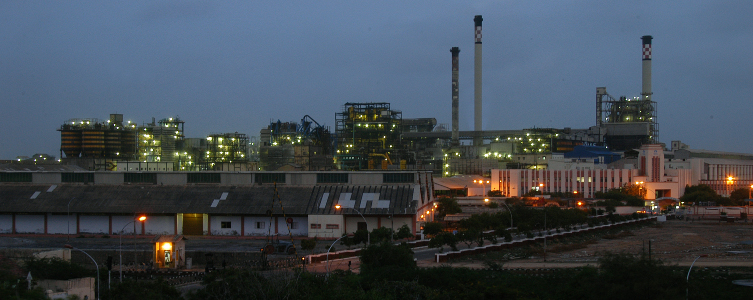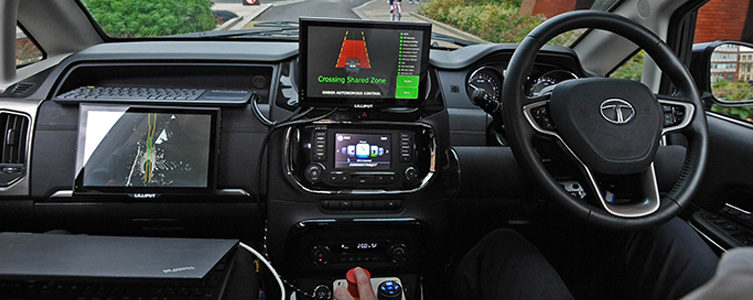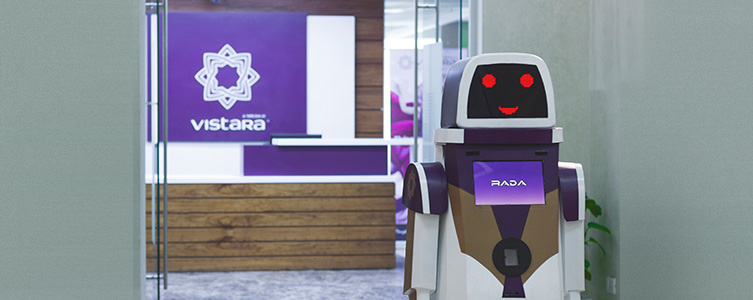March 2019 | 2951 words | 11-minute read
The future of the digital world lies in how people and ‘things’ will interact with each other. The convergence and consolidation of various digital platforms is set to create an industry-wide ecosystem that will connect industries, markets and businesses across the globe, creating new patterns of consumption, new ways of learning, altered workspaces and enhanced lifestyle. Here's how Tata companies are leading from the front.
Future Of Technology
Tata Communications, leading digital infrastructure provider, recognises the importance of connectivity and has built the world's largest IoT network based on LoRaWAN™ technology, spanning nearly 2,000 communities and touching over 400 million people. To date, the company has deployed the LoRaWAN™ network in 38 cities in India and intends to cover most of the country by 2019.
“Our LoRaWAN™ network was recently used for the deployment of 300 smart street lights in Jamshedpur. This project sought to optimise electricity consumption by implementing street lights across India with smart features such as switching the lights on and off or dimming them remotely from a central command centre on a need basis,” says Sumeet Walia, executive vice president, Tata Communications.
“LoraWAN is also being used to deploy other Smart City applications across Jamshedpur,” said Mr Jayanta Banerjee, chief information officer, Tata Steel. “A POC has been developed to monitor the fill-up of garbage bins placed across the city thereby enabling efficient planning of garbage retrieval. A smart parking POC has also been developed and are being scaled up.”

Tata Consultancy Services (TCS), with its machine first philosophy, has been in the forefront of doing some “cool things” with IoT platforms like TCS Connected Universe, cognitive automation platform ignio™, AI and other machine learning platforms. The company is harnessing these technology platforms in several areas like application of drones in disaster management, pipeline monitoring and cobots (collaborative robots which can physically interact with humans and share a common workspace).
“Machine first gives you a formal way of integrating the multiple technologies available to deliver value for business and translates into leveraging technology -- first to do what can be done using it and then to elevate human capability to the next level, what you call ingenuity and innovation,” says PR Krishnan, executive vice president and global head, Enterprise Intelligent Automation, TCS.
TCS is part of several interesting projects that apply its cutting-edge technology. Among them is the use of its IoT technology by the aircraft engine manufacturer Rolls Royce.
“There is a lot of intelligence that you could gather from that, in terms of engine condition, various sensors and parts of the aircraft. The data allows you to maintain or predict when the aircraft is likely to run into maintenance problems, when is there going to be wear and tear on one of the engine’s blades, when a hydraulic system reaches its end of life. This not only allows aircraft manufacturers to address these concerns but also helps enhance business and productivity,” says Krishnan Ramanujam, president, business and technology services, TCS, which is leveraging IoT, through the Remote Energy Management System, to manage its own energy consumption across premises in India.
“Suddenly, things that were difficult to do because image data was not available can now be accomplished with drones; you are able to work around these types of problems. We are also working on new areas in industrial robotics, where you can have humans and machines working together in a collaborative mode — cobots. These can work in plants and assembly line jobs,” says K Ananth Krishnan, executive vice president and chief technology officer, TCS.
AI and IoT provide you with a lot more sophistication in decision making and eliminate rudimentary repetitive task, he adds.
Future Of The Workplace
Manpower intensive, high-risk jobs, especially in the manufacturing sector, may soon be a thing of the past. Companies across the board are realigning their workforce and customer facing processes, using IoT, AI, automation and robotics to enhance productivity, upgrade talent and create safer work spaces and customer engagement. But for companies like Tata Chemicals and Tata Steel — with a legacy, both in terms of value and property — digitising operations and plants takes on a very different hue. Different plants are of differing age and so is their functioning.
“We are taking large pieces of our key manufacturing processes and creating a digital twin by simulating it digitally and observing how that operates to optimise a particular operation,” says Zarir Langrana, executive director and president - Global Chemicals Business, TCL.

The technique involves putting sensors at various points in the plant to allow continuous monitoring of operations and offering predictive analytics on optimisation, early warning preventive maintenance, operational safety, remote operations, etc. Based on two to three key technologies, the project, being executed in collaboration with TCS, is responsible for building the digital twin and process optimisation of its utilities.
In its global chemical business and consumer product vertical both customers and suppliers are onboard digital platforms, enabling online transactions, order placements, tracking of orders, viewing of accounts statements and customer and supplier feedback thereby providing a 360-degree view to their vendors and customers. of the plant at anytime, anywhere. The company is also piloting wearables for all employees at Mithapur to provide an added protective layer of safety and to up its safety standards.
“We are dealing with global majors as our key customers, and you need to give them confidence that they are seeing an operation which is operating at optimal levels and providing product and service levels that are world class,” says Mr Langrana.
Going ahead, the company aims to implement the new technology at all its plants and apply predictive analysis to offer better solutions and services.
Mr Banerjee at Tata Steel agrees. “As an organisation with over a century of existence, transformation of any nature is not a trivial choice or decision. We started off creating a pull at the top with awareness building programs like Reverse Mentoring, which saw young employees mentoring the senior leadership. We also co-developed digital capability development programmes for all employees, including at the mines.”
He adds, “We've now pivoted to focus entirely on leveraging technology for business transformation and value creation. We believe data will be our “New Ore”, which will be the source of our competitive advantage going forward.”
Companies like Tata Projects, meanwhile, are using technology to overcome industry specific hurdles like terrain. From using helicranes for transmission line execution for the first time in Southeast Asia to using mechanised track laying machines in dedicated freight corridors, it has clocked many firsts.
Tata Projects has further embraced the future of construction by working with processes like Building Information Modelling and developing cobots. The former allows architecture, engineering and construction professionals to plan and execute projects with ease by enabling them to align their labour and estimate quantities in advance and resulting in faster delivery, lesser wastage and more environment-friendly projects. The latter involves humans and robots working side by side safely, resulting in greater operational flexibility and agility.

Future Of Travel
Tata Motors is at the forefront of future-ready travel. Electric vehicles (EVs) and autonomous vehicles aren’t just trending hashtags of the auto industry, they are big-money investments that are set to change the journey ahead, and Tata Motors is leading the electric mobility evolution in India. They have delivered 330 Tigor EVs and the Tata Starbus hybrid electric bus is set to be on the roads in six Indian cities.
“Our facilities are evolving towards seamless human-machine connectedness. At our Engineering Research Centre, we are doing R&D on advanced driver assistance systems (ADAS) as well as full vehicle autonomy, to be future ready. Autonomy will be a consideration for the future in India. As the UK has published a code of practice for testing autonomous vehicles safely and legally, it provides us with the ideal platform to enable us to challenge our self-driving vehicle capabilities,” says Rajendra Petkar, chief technology officer, Tata Motor, noting that their ongoing trials on the HEXA have yielded rewarding insights.
Meanwhile, the Tata Motors-owned Jaguar Land Rover (JLR) is developing fully- and semi-automated vehicle technologies, offering customers a choice on the level of automation, while maintaining an enjoyable and safe driving experience. The brand’s ‘CORTEX’ project — a ‘5D’ technique combining acoustic, video, radar, light detection and distance sensing (LiDAR) technology — forms part of the company’s vision to make the self-driving car viable in the widest range of real-life, on- and off-road driving environments and weather. Access to this combined data, using 5D, improves awareness of the environment the car is in. Machine-learning enables the self-driving car to behave in an increasingly sophisticated way, allowing it to handle any weather condition — dirt, rain, ice, snow or fog — on any terrain.

In November 2018, JLR pioneered a new technique to reduce motion sickness, the age-old travel malaise by at least 60%. The technology uses non-invasive biometric sensors to record physiological signals, which combined with motion and dynamics data, give an individual score to a passenger, essentially detecting motion sickness even before they experience the symptoms. The score is calculated using a device, which is still in development and undergoing patent approval.
“This informs future concepts such as the direction of travel in autonomous vehicles,” says wellness research engineer, Spencer Salter, JLR. “This research has allowed the creation of a drive-style benchmark to ensure our autonomous development is the smoothest, least motion-sickness inducing and, ultimately, will enable a cabin most set up for performing other activities.”
JLR has also developed the audible vehicle alert system (AVAS) for the I-PACE, to address vulnerabilities stemming from the absence of traditional engine noise in EVs. The lack of noise creates a problem for pedestrians, such as the visually impaired.
“JLR’s engineers worked for four years to develop a soundtrack that is audible yet discreet and cannot be heard from inside the vehicle. Initial attempts to create a noise, inspired by the sound of sci-fi spacecraft, had to be shelved after pedestrians reacted by looking up to the sky rather than the road, as the vehicle approached,” says Iain Suffield, JLR noise, vibration and harshness technical specialist.
Engineers tested sounds in varied environments, including an anechoic chamber (specialist echo-free room) and various urban scenarios, before settling on the final sound. It is emitted from a speaker located behind the front grille; the sound can be heard in every direction and cannot be disengaged.
The alert increases in pitch and volume in line with the speed of the vehicle and, when in reverse, is accompanied by an additional tone that indicates the change in direction.
Both Tata Motors and JLR are also working on developing passenger and commercial vehicles that take the lead in driving zero-emission technologies. In line with the One Tata spirit, Tata Motors is leveraging the capabilities of group companies like Tata Power, which is installing charging units across Mumbai and Delhi, to develop a full ecosystem for EVs.
Future Of Sustainability
Tata Power, India’s largest integrated power company and one of the country’s largest alternative energy companies, has already installed 15 EV charging units across Mumbai and Delhi while ensuring that grid stability is not adversely affected during vehicle charging.
Tata Power is meeting the future of energy head on with ‘smart’ offerings like a ‘behind-the-meter’ solution for residential consumers that automates the operation of energy-consuming appliances and devices at home. The consumer can monitor the energy consumption live, switch on/off appliances and devices and receive suggestions on optimising energy consumption to achieve reduction in energy bills. This solution is not restricted to Tata Power’s distribution license areas; the company has made it available to consumers anywhere in India.

Future Of Experiences
In the quest to be future ready, a common thread running across companies and sectors is that the ‘Customer is king’. And with smart phones, social media apps and a camera in every hand, keeping pace with the customer requires companies to think creative, afresh and sometimes outlandish.
Vistara, the Tata and Singapore Airlines joint venture, understands the need to innovate and make air travel seamless and personalised. It introduced India’s first robot RADA, to assist and interact with travellers at airports and, in turn, redefine the on-ground experience. For now, RADA provides flight information, destination city, flight updates, basic customer queries and entertains travellers at the airline’s exclusive lounge at Delhi airport’s Terminal 3. The airline wants to develop RADA to perform more advanced interaction with passengers in future.
“At a time when ‘experience’ has become more important than ‘things’, the basic premise behind RADA was to develop a simple and extremely cost-effective robot that can engage in basic human interaction to begin with and can be further developed to perform more complex tasks. Another key focus area for us was to create RADA indigenously — to make in India with all things Indian,” says Ravinder Pal Singh, chief information and innovation officer, Vistara.
Future Of Life
The world we live in is only going to get smarter. Smart phones will extend to become smart homes, smart cities and smart nations. The trials have begun, and the House of Tata has already made its move. In fact, several Tata companies have played pioneering roles in smart city projects across the country and the globe.
Among the key players in this space is Tata Elxsi. The design company has worked on several projects, which include the Kochi metro, India’s first award-winning integrated transport system; autonomous car projects with auto majors, including JLR.

“Whether you should use IoT or how much AI is applicable, all those decisions will be made later. We, as an organisation, understand that design must lead. And that was the pitch we took to the Indian government and that’s what they are doing to Kochi metro, the first integrated transport system for the country. The key is to be able to sell a passenger experience. Our job as the principal consultant was to drive the passenger experience as a seamless entity across all vendors,” says Nitin Pai, senior vice president and head, marketing, Tata Elxsi about the Kochi metro project that won them the iF Design award.
He adds, “Going ahead, experience is what will rule customer service. IoT gives customers the power to access and control a service — whenever, wherever, whatever. This gives the consumer choice but what about decision making. It is here that AI steps in. By collecting data of the past and present, it recommends what you choose. However, true comfort and convenience will come when it makes the decision for you. This is where the world is going. That’s how we are seeing the smart home and cars progressing.”
Future Of India
The Tata group has always been part of India’s growth story and the future is no different. In September 2018, Tata Aerospace & Defence signed the landmark agreement with Lockheed Martin Aeronautics to manufacture the complete wing for the F-16 Block-70 fighter aircraft in India for export — putting India on the world map as a hub for sourcing complex aerospace assemblies. TASL is also one of only three companies chosen to build satellites for the Indian Space Research Organisation for various applications, including communication, remote sensing and navigation services in areas like tele-education, tele-medicine and disaster management support.
Tata A&D is also one of the two development agencies nominated by Defence Research and Development Organisation to design and develop an indigenous 155mm 52 calibre Advanced Towed Artillery Gun System. This gun system incorporates futuristic technologies in electrical, electronics, mechanical design and analysis and is likely to replace an ageing inventory of guns currently with the armed forces.

And India’s first indigenously developed robot — TAL BRABO is finding newer applications in various sectors, including automotive, electronics, software testing, plastics, logistics, aerospace and heavy engineering. This ‘Made in India’ industrial robot has catered to manufacturers ranging from micro to large scale.
“As robotics and automation grow in importance, it has become imperative to train the future workforce for a smooth transition. We have also come up with TAL BRABO ROBOWHIZ, an education robot designed to cater to the education sector. ROBOWHIZ will help reduce the gap between industry and academia and develop a curriculum for training the incoming workforce to work with industrial robots,” says Amit Bhingurde, chief operating officer, robotics and automation, TAL Manufacturing Solutions Limited, which is being consolidated into Tata A&D.
As we move towards a more connected world, the future is ridden with doubts. Some believe it’ll be a fight for supremacy and some say it’ll be an equilibrium mankind has never seen, but there is no denying that as technology takes precedence humans have to realign their roles.
“While on one hand it may look like technology is eliminating jobs, on the other hand, it will give rise to a lot of newer jobs that are at a higher plane of cognitive capability. This is what the man-machine relationship has always been like and this time will be no different,” says Mr Ramanujan.
—Sanghamitra Bhowmik








